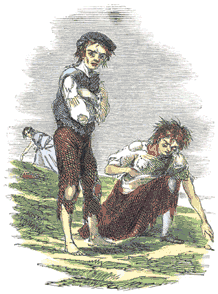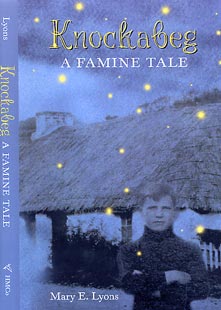|
 DRAW A
TROOPING FAERY DRAW A
TROOPING FAERY
Hint: If you’d like to see your drawing posted here in the Lyons Den,
ask your parent or teacher to send an email to the author at mary@lyonsdenbooks.com.
Tips:
Trooping faeries are about two feet tall. They wear belled red caps with
owl feathers, and have potbellies except in famine times. When going to
war, they carry a squirrel-skin pouch stuffed with faery darts.
The queen of the Trooping Faeries is a bit taller than most. She wears a
spangled cape and eyeglasses.
Mungo, Wink, and Jam are the queen’s Steps. As members of her High
Council, each wears a scarlet cape with his initial embroidered on the lapel.
Mungo is handsome, Wink wears a checked vest, and Jam is rather roly-poly.
Sticky is shorter than most Trooping Faeries. As High Council
member-at-large, she also wears a cape embroidered with her initial. But she
doesn’t look quite like the other Trooping Ones. She’s only a foot tall, her
hair is chopped off, and she wears gloves of dried sea foam. She carries a rose
thorn needle and a silver comb.
 NAME
THAT FAERY! NAME
THAT FAERY!
Look at the cover of Knockabeg. Pretend the lights are faeries from
the book. Could one of them be the queen? Sticky? Mungo, Wink, or Jam? Use a
yellow crayon or marker to draw similar lights on a piece of blank paper. Label
each light with the name of one of the characters.
 BUILD A FAERY VILLAGE BUILD A FAERY VILLAGE
Faeries make use of small things found outdoors. In Knockabeg, for
example, they drink from acorn cups, build tents from bark, and carry umbrellas
made of the wild flower known as Queen Anne’s Lace.
Walk through your yard or neighborhood and collect items that faeries might
use, such as twigs, leaves, pebbles, feathers, and wildflowers. Build a faery
village using what you’ve found. Remember that Knockabeg faeries live
under bushes, inside mountains, or within a shelter made of rocks.
Warning! Mushrooms found outdoors can be poisonous to humans. Don’t
touch them or use them for your faery village. And be sure to wash your hands at
the end of this activity.
 SEE A FAERY FLOWER SEE A FAERY FLOWER
Some flowers, mushrooms, and even birds are named after faeries. Look in the
dictionary under fairy or faery and notice how many are listed.
For example, you’ll see that the flower known as foxglove is also
called a fairy cap, fairy bell, fairy finger, or fairy glove. View
a picture of a foxglove blossom.
 IMAGINE THE GREAT
HUNGER IMAGINE THE GREAT
HUNGER
Knockabeg: A Famine Tale is based on stories that the Irish told about
faeries helping human beings during Ireland’s worst famine.
Sometimes called the Great Hunger, the famine led to the death of millions of people
who died of starvation after potato crops rotted on the vine.
Photographs help us understand the horrors of American slavery and the Jewish
Holocaust. Yet no photograph of Ireland’s worst famine is known to exist. One
Irish newspaperman made this sketch when he traveled through the stricken
country in 1847. The children are desperate for something to eat. Perhaps
they're looking for a potato that hasn't turned black yet. Or they may
be picking weeds and grass to eat. Sometimes the starving Irish even ate
beetle larvae.
 Right-click
on the image with your mouse and choose print. After you’ve printed the
image, try to imagine how these children feel. What could they be thinking?
Write their thoughts below the picture. Right-click
on the image with your mouse and choose print. After you’ve printed the
image, try to imagine how these children feel. What could they be thinking?
Write their thoughts below the picture.
Boy and Girl at Cahera
|


